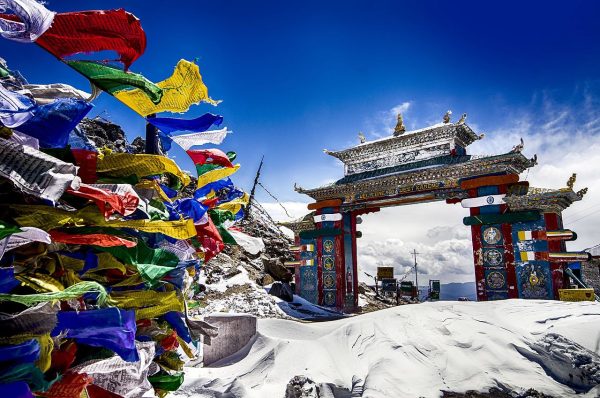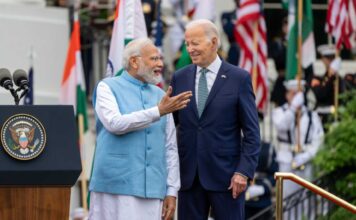By Maj Gen Sudhakar Jee
Dragons in Chinese culture are believed to be friendly, auspicious, and usually lucky — symbols of great power, good fortune, wisdom, and health. But China as a country under communist party wants to appear friendly but remains janus-faced to almost all of its neighbors.
President Xi Jinping is now confirmed for his unprecedented third tenure. Communist Party of China’s (CPC) new goal is ‘qiang zhongguo meng,’ meaning a strong nation’s dream and to be at the centre of the earth, through multiple means.
China needs to keep its growing middle class occupied and nothing can be better than war to keep them engrossed. Thus, China under western pressure becomes more dangerous for its neighbors.
India’s Concerns
India and China share a 3488 km frontier of unsettled borders. The Chinese provocation at Yangtze in Dec 2022 was an indication of its intention especially in Sikkim and Arunachal Pradesh. The issue of Tibet is still unsettled for China and Tawang in Arunachal Pradesh has its own importance in the whole saga.
China is an atheist country but interestingly it wants to assert its control over a Buddhist monastery that is also inside Indian territory.
The chicken neck or 22 km wide Siliguri Corridor makes India particularly vulnerable as it is vulnerable to enemy gunfire from the Jampheri ridge in the north from Bhutan’s territory. China’s southward push in the Chumbi valley in the Doklam region is aimed at establishing a position at Jampheri Ridge.
Though, India has done well in the north-east in recent years to control the insurgent groups by trying to bring them into the political mainstream. Thus, the option for China to fuel an internal disturbance in the Indian territory has now faded away. The condition of Myanmar under Chinese influence is also directly felt by the people of northeast. Thus, the only option that remains with the Dragon is to hold India by chicken-neck.
Water diverted through three gorge dam and vulnerability of Brahmaputra – the lifeline of the northeast, is also a major concern for India vis-s-vis China.
Chinese cargo is already sailing to Yangon port in Myanmar up to Chengdu, the capital of China’s landlocked southwestern province of Sichuan by rail-road network developed recently. Thus, after solving its ‘Malacca Dillemma’, China will now focus on neighbors who could steal its ‘world’s factory’ status.
India’s response, so far
The Indian government has taken up many infrastructure projects in the northeast state for providing better road and rail connectivity for the people and the army alike. Schemes like ‘vibrant villages’ are aimed at encouraging locals to stay by providing them modern amenities, schools, health facilities and telecommunication.
India is also promoting tourism in far flung areas of Arunachal Pradesh for increasing local employment and a sense of bonding between the citizens of the rest of India with the northeast states.
Race to build dual-use infrastructure
The G-695, a highway connecting Xinjiang and Tibet runs along the hotly contested areas towards India’s side of G-219 and G-318, will further enhance the connectivity of PLA deployed in forward areas.
A new railway line will start in Shigatse in Tibet and would cover new routes up to borders with India and run northwest along the Nepal border before piercing north via Aksai Chin, broadly following the National Highway G-219’s alignment and ending at China’s Hotan in Xinjiang.
China is also extending the Lhasa-Xigaze railway line southwards to Yadong, a trading town near the strategic Nathu La, near western Bhutan. Here, China has territorial claims of the Doklam plateau contested by Bhutan.
Flashpoints in the Eastern Sector
Traditionally there are eight flashpoints in the eastern sector of the Line of Actual Control (LAC) with China but we list here a few, which could become troublesome anytime.
Doklam and Jhamperi
A Chinese village named Pangda built around 9 kms east of the Doklam plateau, is now fully inhabited. In addition, construction of another village in the Amo Chu river valley has been completed, and work on a third village located further south is learnt to be nearing completion.
China is constructing an “alternate axis” connecting the above villages in Bhutan territory to the Jhamperi Ridge aimed at the chicken neck of India.
Arunachal Pradesh
China has expanded its illegal claim of Tawang Plateau to the entire Arunachal Pradesh – 90,000 square kms of territory and started calling it “South Tibet” in 2005.
It has promulgated the ‘new land border laws’ in addition to applying cartographic warfare to include the issue of six ‘official names’ of places in 2017 followed by 15 ‘standardized names’ in 2021, covering 11 districts in Arunachal Pradesh from Tawang in the west to Anjaw in the east.
Further, psychological warfare using print and electronic media has also been launched by China.
Tawang
Tawang is home to India’s largest Buddhist monastery – the second in the world, only next to Potala Palace in Tibet. It enjoys geographic contiguity and ethnic link between the cross-border communities.
Controlling Tawang is part of Chinese strategy to subdue Tibetan religion and culture forever. Chinese claim to adjacent Sakteng wildlife sanctuary of Bhutan in June 2020 was also part of the same plan.
Jerjang Tso, Zimithang
Zemithang Circle is approximately 115 Kms away from Tawang by road. Jerjang Tso, a natural lake in Indian territory is approximately 30 Kms from Zemithang and about 3 Kms south of the tri-junction of the borders between India, Bhutan and Tibet.
Namka Chu is a nullah that originates from Jerjang Tso and flows between Thagla and Hathunga ridge before joining Namjyang Chu, south of Khenzemane. At this place, the Dalai Lama had entered India after escaping from Tibet in March 1959.
China is constructing a road through Shapo village, on the China side of Thagla ridge towards Jerjang Tso. Once completed, it will enable the PLA to mobilize troops unnoticed and occupy Jerjang Tso faster in future. India lacks the last mile connectivity in the area.
Upper Subansiri district
China had illegally occupied Lhunze or Longju in 1959, barely 15 km from the Upper Subansiri district of Arunachal Pradesh.
People familiar with the mining plan of China in the area say that the rapid pace of development in Lhunze, a traditional military stronghold heavily occupied by the PLA, is part of Beijing’s determined drive to regain complete control of southern Tibet or Arunachal Pradesh.
Conclusion
India needs to protect Jhamperi ridge by all means and countermeasures need to be taken to address China’s strategies in the eastern sector, particularly Tawang.
There is a definitive political will that is now acknowledged by US intelligence agencies recently. But speeding up to establish last-mile connectivity to vital areas in the sector, acquiring desired surveillance and offensive capabilities in order to enhance the conventional and punitive deterrence would help address the threats.













